How simple is too simple in the martial arts? How complex is too complex in pragmatic personal combat? This is a topic of frequent discussion, particularly among combatives exponents. While practical, realistic fighting must indeed be kept direct and functional, I believe it is possible to ingrain through training useful techniques and methods that might at first seem complicated or ineffective.
What characteristics must any system, technique, or “art” possess to be effective? What elevates the useful above the useless? Any combat method or movement can be judged against several key criteria.
Space Domination
To be effective, an art or system must recognize the need to seize the initiative. Known in WWII combatives circles as forward drive, this domination of space encompasses aggressive closing with and overwhelming of an opponent. This drive need not be “straight down the line,” however. Moving off the attacking line – denying your opponent access to your vulnerable centerline – is emphasized in arts like Wing Chun Kung Fu. In the “forward system” of Wing Chun, however, any move off that line is accompanied by aggressive counterattack on a trajectory that makes the opponent more vulnerable (attacking from his blind side is always preferred). Wing Chun emphasizes infighting, closing fast to blitz the opponent’s center with vicious, rapid, repeated blows.
An art that does not recognize the need to seize the initiative – an art that is passive – is of dubious utility in real life. The most passive incarnations of Aikido would fit into this category. The standard by which you must judge an art or system is comprised of the questions, “Does this encourage advance or retreat? Does the practitioner preempt or, if he cannot preempt, take the initiative in conjunction with his defense?”
Execution Under Stress
Many combatives exponents rightly speak in terms of gross motor skills. Fine motor skills go to hell under stress, they explain, meaning any technique that is not simple and that cannot be performed with gross motor movements is best discarded. In practice, however, I’ve found that what is “gross motor” for one person isn’t necessarily so for another, at least until we get to the most fundamental of component movements.
Take, for example, a Filipino Martial Arts (FMA) hubud drill. In this drill, which helps develop “flow” (the smooth transition of movements in fighting and the touch reflexes that facilitate this), one student delivers an edge of hand blow to the neck of a partner. The partner shoots up his own edge of hand on the inside of the incoming strike, using the same side arm. Simultaneously, he brings up the opposite arm under and around the incoming arm to strike that limb on the outside. (If done sharply and vertically, the combined move is a gunting, or “scissor” movement.) The defending student checks the limb and counterattacks with his own edge of hand blow using the opposite hand, at which point the first student defends – and the cycle switches from one to other endlessly.
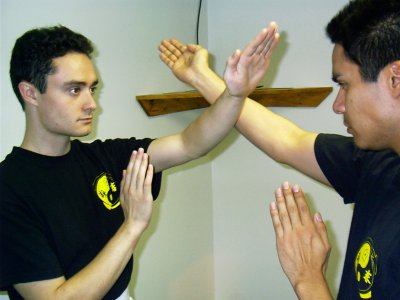
Hubud training. First student (right) attacks and is blocked…
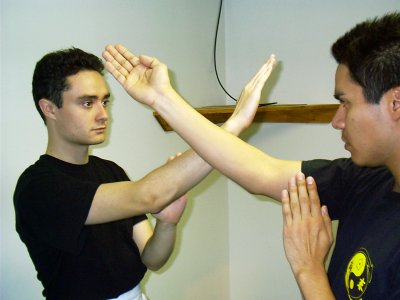
…then struck by second student’s opposite arm…
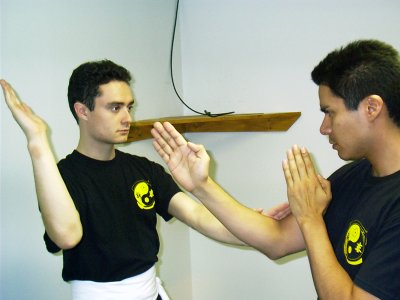
…Then checked by the same-side arm as second student prepares…
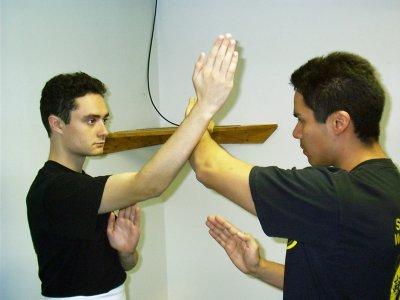
…and counterattacks, as drill cycles and first student switches roles.
It sounds quite complicated and of dubious utility, doesn’t it? What use does this elaborate patty-cake game have in real life? In reality, the application of the skills developed in this type of drill is quite useful and very pragmatic. The key is the training.
Chi sao, the “sticky hands” training of Wing Chun, is much the same as FMA hubud training and develops the same flow, the same touch reflexes.
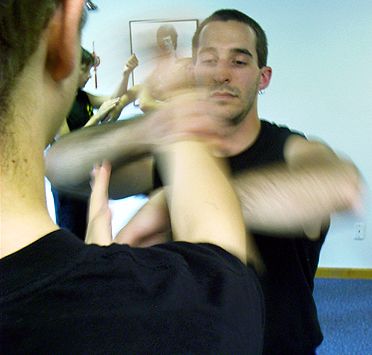
While I took to the hubud drill described immediately on my strong side when I first tried it, I found it extremely awkward on my weak side. After a few repetitions, however, I was moving fast enough to bruise the forearms of two training partners. I had previous FMA and stickfighting training, so the basic horizontal-vertical conceptual motions and the strike-hit-check-hit combination came very naturally.
Under stress – that is, without thinking about it – I’ll often perform these combinations. (Another combination I do instinctively that was not natural to me at first is bon sao-lop sao, part of a chi sao drill that involves circular under-over movement of the arms culminating in a backfist to the opponent’s head.) These combinations are instinctive because they were ingrained through training and for no other reason. They are now part of my “gross motor skills,” whether I wanted them to be or not.
Physical response, then, can be trained to the point that it is instinctive, as can almost any set of movements. The more involved the movement, the more training time is required. Granted, exponents of only the simplest offensive techniques are right in pointing out that their methods are quickly trained. If one finds enjoyment in investing extended training time, however, there are many seemingly complex arts that can be ingrained to great efficacy. The flow such practice develops helps enhance one’s response times and makes one comfortable with a greater variety of responses – whose motor demands might elude practitioners with less training.
Power
To be useful, a martial art or combative technique must have power. I’ll use the previous examples – Wing Chun and FMA – to elaborate.
A check to the forearm in FMA is a pak sao – a slapping block – in Wing Chun. (Wing Chun and FMA complement each other quite well, in fact.) In practice with hubud drills or in pak sao drills, the technique can seem limp and unimpressive, especially among low-level students. Practice the technique properly, however, and it is delivered with shocking speed and traumatic power. My Wing Chun instructor, demonstrating a check on me, slapped my arm with such force that I dropped my guard without wanting to do so. As I write this, I have a bruise the size of his palm in the spot where he checked me. His guntings are even more traumatic.
What can seem listless or lacking in true power in the early stages of training can become hard and fast when done correctly and with proper foundation. Blunt force will work, but sharp snap works just as well if not better.
An art or system that does not generate true power is largely useless. The absence of power translates to the absence of forward drive and the inability to dominate space.
Weapons
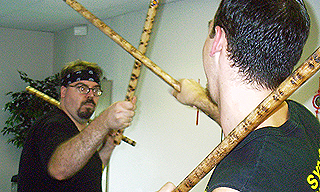 Any system that does not recognize the utility of weapons or the place of weapons in the continuum of force is not necessarily physically useless in other respects. It is, however, incomplete. It encourages the development of a dangerous conceptual blind spot in its practitioners. In this way it is worse than useless; it is deliberately self-limiting. Avoid any martial art or system whose practitioners or instructors profess a disdain for or fear of weaponry.
Any system that does not recognize the utility of weapons or the place of weapons in the continuum of force is not necessarily physically useless in other respects. It is, however, incomplete. It encourages the development of a dangerous conceptual blind spot in its practitioners. In this way it is worse than useless; it is deliberately self-limiting. Avoid any martial art or system whose practitioners or instructors profess a disdain for or fear of weaponry.
Do What Works
Personal combat should be, to quote gratuitously, “nasty, brutish, and short.” The components of that combat could vary in degrees of complexity and remain effective across the spectrum of that variation. If what you do dominates space, can be performed by you under stress, generates true power, and incorporates realistic use of force-multiplying technology, you are doing what works.
Keep it functional and you keep it feasible.